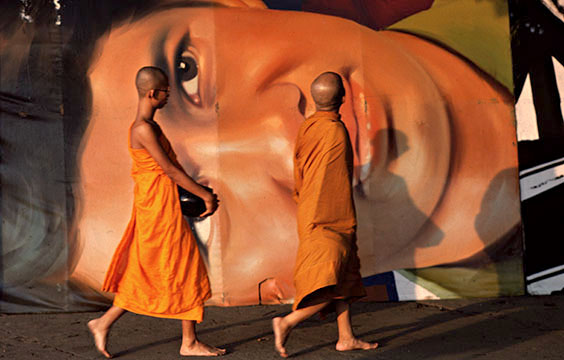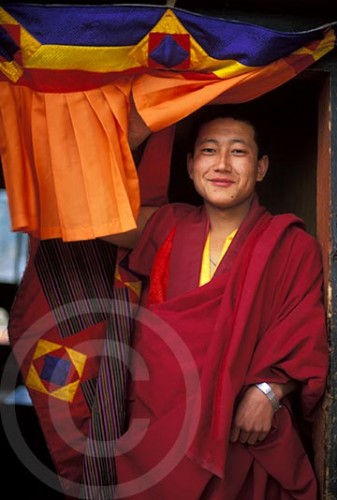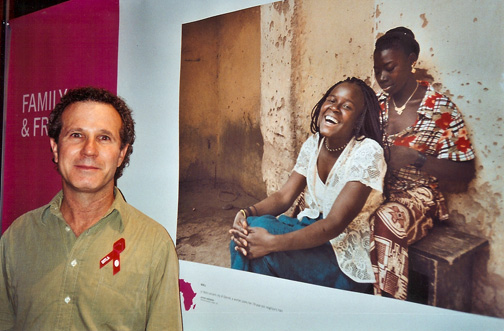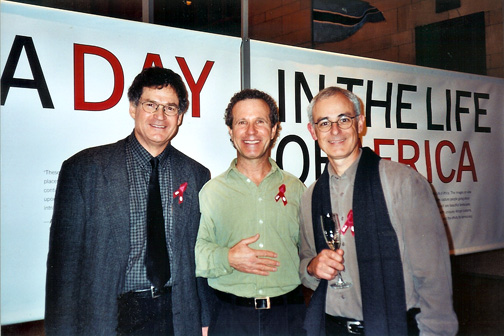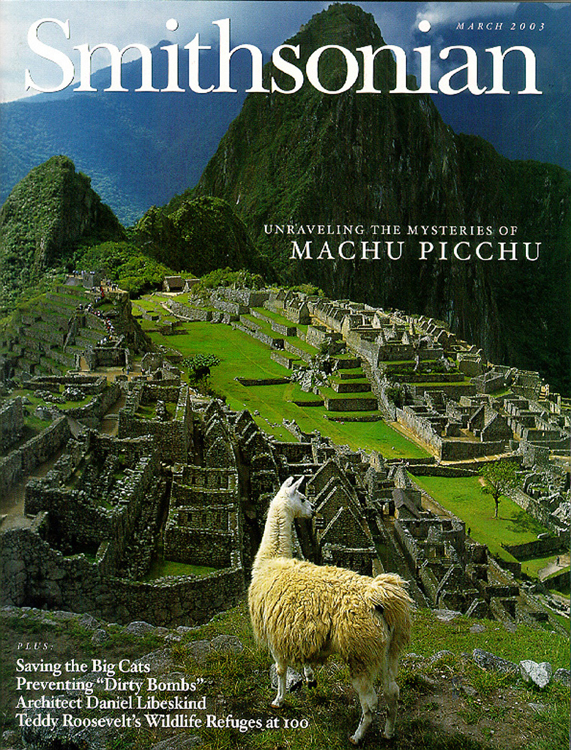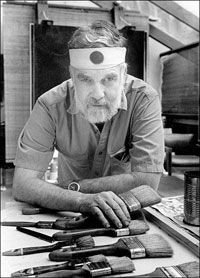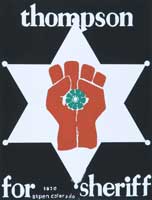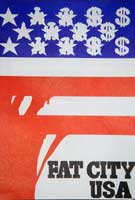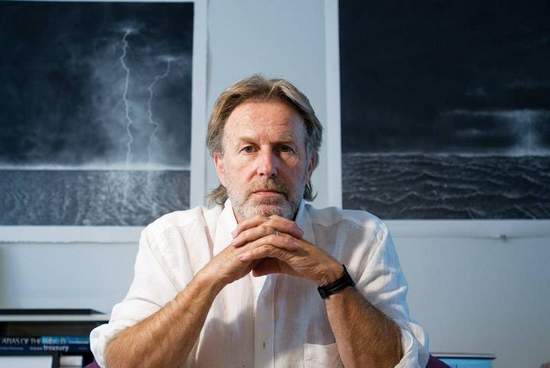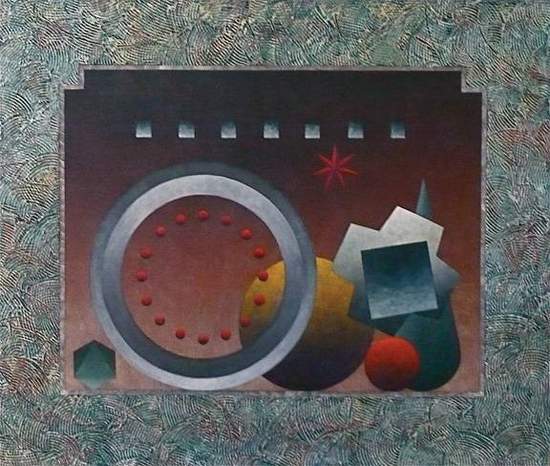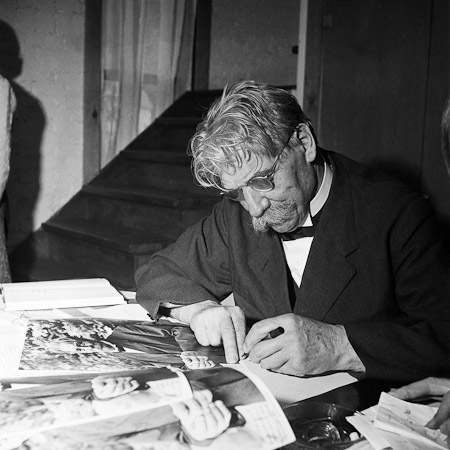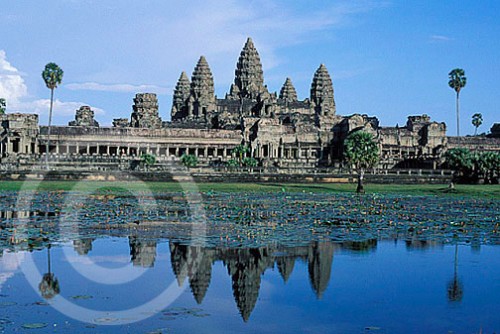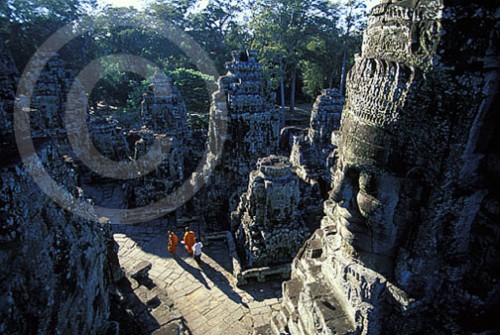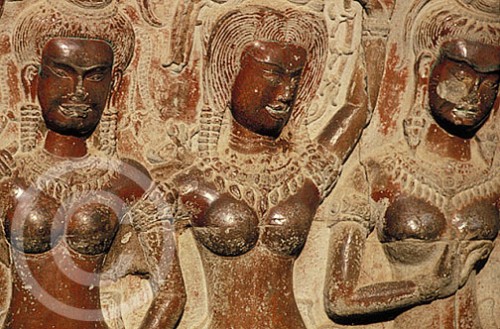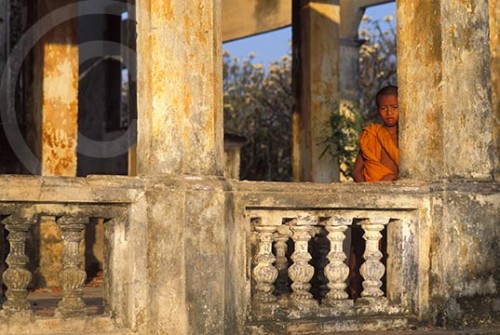9/22/11
Behind the Scenes: It’s 1982 and dense golden light bathes the streets of Bangkok, Thailand. Jeffrey is in the city photographing the 200th Anniversary of this vibrant and complicated capital. As he walks through the downtown area at dawn, he spots a large hand-painted movie poster about to be erected for American Gigolo.
The billboard, laying on its side, is a visual feast, and the perfect backdrop for creating an image that represents the often-unusual contrasts found in East meets West moments. Jeffrey composes his photograph then waits until two monks begging for morning alms walk into his frame, capturing their curiosity as they stand face-to-face with American heartthrob, Richard Gere.
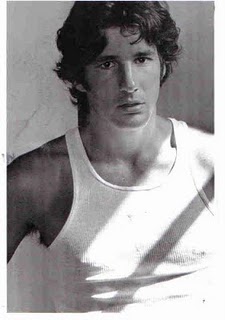 Squint and turn your head sideways and you can almost see Gere’s resemblance in this Asianized version. If not, you may need to squint a little more!
Squint and turn your head sideways and you can almost see Gere’s resemblance in this Asianized version. If not, you may need to squint a little more!
This photograph was created with a Nikon FE camera, a Nikon 24mm lens and Kodachrome 64 film.
It has been published several times, acquired by private collectors, and has even caught the attention of Richard Gere.
__________________________________________________________________________
9/29/11
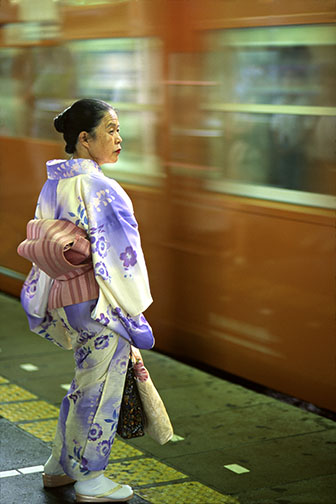 Behind the scenes: It’s 1992 and Jeffrey is working on assignment for Travel Holiday, doing an editorial feature on rice in Japan. He’s photographing everything from sake factories and rice farmers to the cultural and religious significance of rice.
Behind the scenes: It’s 1992 and Jeffrey is working on assignment for Travel Holiday, doing an editorial feature on rice in Japan. He’s photographing everything from sake factories and rice farmers to the cultural and religious significance of rice.
Because taxis in Tokyo are exorbitant, he decides to do his client a favor and take the subway to a Shinto shrine where he’ll be photographing a ceremony involving rice.
Inside Shinjuku Station, as he stands in line waiting for the train, he notices a woman near the front wearing a traditional kimono–something seldom seen in modern Tokyo anymore.
Jeffrey knows this is a perfect opportunity to create a photograph showing the contrast between old and new. Quickly he pulls out his camera, steps out of line and tries to frame the image. Within minutes the train arrives. He has just enough time to shoot off two frames, capturing this fleeting moment, before jumping aboard the train with the rest of the passengers.
This picture, which was created with a Nikon F4 camera, a Nikon 85mm lens, and Fuji Velvia film, has been honored with a PATA Gold Award and has also been published on the cover of several magazines.
Earlier this year Jeffrey also donated this photograph to Life Support Japan to help Japan’s tsunami and earthquake victims. The fundraising relief effort was organized by Crista Dix of Wall Space with the help of Aline Smithson of Lenscratch, and raised over $50,000 for Direct Relief International and Habitat for Humanity in a matter of days.
If you’d like to know more about this project you can click on this link: Life Support Japan.
If you’re interested in seeing more of Jeffrey’s photographs from Japan, you can click on this link: rice in Japan.
___________________________________________________________________________
10/13/11
Behind the Scenes: It is the year 2000 and Jeffrey has been hired by Wired Magazine to photograph a feature story about Bhutan, the last country in the world to get television.
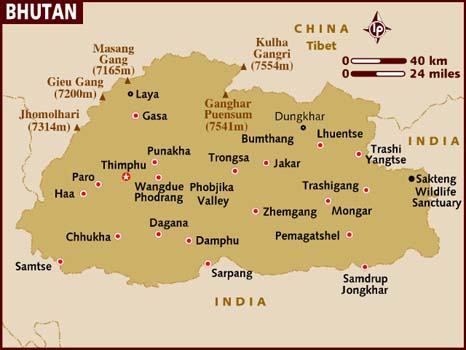 Bhutan, known by its people as Druk Yai (Land of the Thunder Dragon), is a small landlocked kingdom sandwiched high in the Eastern Himalayas between Tibet, China, and India. Primarily Buddhist, it has been named numerous times as one of the happiest places on earth. Its king proclaimed “Gross National Happiness is more important than Gross National Product.
Bhutan, known by its people as Druk Yai (Land of the Thunder Dragon), is a small landlocked kingdom sandwiched high in the Eastern Himalayas between Tibet, China, and India. Primarily Buddhist, it has been named numerous times as one of the happiest places on earth. Its king proclaimed “Gross National Happiness is more important than Gross National Product.
Bhutan has held on tightly to its culture for centuries. It only allows about 7,500 tourists a year to enter, and within the country police are empowered to detain any Bhutanese not wearing official national dress, the robelike gho for men and the jacket and apronlike kira for women. The king is only allowing television to be introduced because he feels his country needs to keep up with the modern world.
After flying on Druk Air into Paro, Jeffrey travels to the capital of Thimpu. Here he’s lead to a small hamlet on the outskirts of town, where the Oko Thsering Family has just acquired a TV. They are the only ones in the entire area with this new contraption and they aren’t sure what to make of it yet. Jeffrey photographs the family, along with several of their friends as they watch it.
Much to Jeffrey’s dismay when the television is turned on, the first thing they see is World Wide Wrestling, followed by Felix the Cat cartoons, then finally Oprah, which you can see in the image above. He knows at that moment, Bhutan will never be the same.
If you want to know how television has affected Bhutan, take a look at this 2003 article in the Guardian called “Fast Forward into Trouble.” Perhaps you can tell by the title that introducing western values into this culture has not added to Bhutan’s Gross National Happiness.
To see more of Jeffrey’s photographs from Bhutan, click on the picture of the monk below:
__________________________________________________________________________________
10/20/11
Behind the Scenes: It’s February 28, 2002 and Jeffrey is working on A Day in the Life of Africa, a book project in which nearly 100 photographers from around the world are participating in a historic, one-day documentary of Africa.
Photographers are spread out across 50 nations, from Cairo to the Cape of Good Hope, all trying to capture what is unique about the people, geography, and customs of this continent.
Jeffrey has chosen the West African nation of Mali—specifically, Mali’s medieval city, Djénné. He is intrigued by its massive Grand Mosquée, which is not only the largest mud-brick building in the world, but also a UNESCO World Heritage Site. Built in 1905, it was modeled on a mosque first erected on the site in the 11th century. Every year, after the rainy season, much of the population helps repair and resurface the mud walls.
 On the day of the shoot, Jeffrey and his interpreter Musa (Moses), drive all the way from the capital of Bamako, about 250 miles away, then immediately seek out the Imam, the leader of the Djénné Islamic community. They know they’ll need his permission to enter the mosque.
On the day of the shoot, Jeffrey and his interpreter Musa (Moses), drive all the way from the capital of Bamako, about 250 miles away, then immediately seek out the Imam, the leader of the Djénné Islamic community. They know they’ll need his permission to enter the mosque.
The two venture down narrow dirt alleyways, passing modest mud-pressed houses, eventually ending on the steps of the Imam. When the leader welcomes them inside, Jeffrey can’t help but notice an exquisite Swiss-made grandfather clock as well as a large-screen television.
As is customary, the three men have tea, then Jeffrey finally asks the Imam (through Musa) if it’s possible to photograph inside the mosque. The Imam rubs his chin, then promptly says, “No, it is not possible.”
Jeffrey, who has flown half way around the world to photograph this landmark, tries to keep his cool. “Why?” he simply asks.
The Imam replies, “No non-believers are allowed inside the mosque.”
Then he begins a long, convoluted story about how an Italian fashion photographer had recently been allowed in, deceiving them with his project, and bringing shame to their community. “He asked my permission, which I granted,” the Imam fumes, “then he took a woman there and had her remove her proper clothing to be photographed in a swimming suit. That is against our beliefs. We can no longer allow non-Muslims or non-believers inside.”
Jeffrey can feel the weight of his response pressing on his optimism. Not to be dissuaded though, he continues his appeal. “I will only be going in with Musa, and I will abide by all your rules. My only objective is to show the world what a magnificent place of worship you have here in Djénné.”
The Imam does not budge in his response. Jeffrey continues, “All the money raised from this book will go toward AIDS awareness in Africa. I only want to do something that is good for your people.
The Imam listens to Jeffrey’s plea, then suddenly begins hinting at a bribe. “See this fine grandfather clock. A very important person donated this to me when he wanted to see the mosque. And see this television? That was another donation by another important person.”
Jeffrey is immediately disgusted. “I’m sorry, but my only donation will be making a photograph that will show the beauty and magnificence of your mosque. And that donation will contribute to the book, which will raise money for the African AIDS Education Fund–yet another donation. If that is not enough, then I will not be able to photograph inside.”
As Jeffrey and Musa leave, Jeffrey starts thinking of Plan B. He tells Musa, “We are going to walk around this entire mosque—all 360 degrees—until we find a place that will be even better than if I had photographed inside.”
It doesn’t take long because as they’re walking down a narrow alley, Jeffrey notices a man praying on top of a nearby house. Musa talks to the man and explains what Jeffrey would like to do. In no time, they are up on the roof creating the photograph you see above. It not only captures the grandeur of the mosque, also but gives a broader glimpse into the culture of Mali.
Jeffrey had several other photographs of Mali published in the book as well.
You can see the tapestry of images from this project and a list of the participating photographers by clicking on the links below:
Washington Post slideshow of images from A Day in the Life of Africa.
Photographer profiles and the countries in which they photographed.

- Jeffrey and Becky Aaronson at the Grand Central Station opening for A Day in the Life of Africa
- __________________________________________________________________________________
- 10/27/11
- Behind the scenes: It’s 1999 and Jeffrey is photographing on assignment in Morocco for Travel Holiday. The story he is working on highlights the important role women play in this North African country, even though many are not allowed to work.As Jeffrey strolls around the lively Jemaa el Fna Marketplace in Marrakesh’s old medina quarter, he breathes in the savory aromas of late afternoon. Along the way he photographs an array of vendors selling fruit, spices and kabobs as well as several flamboyant water sellers, fire eaters and snake charmers.In the midst of this bustling scene, he notices a woman wearing a blue hijab. Her striking almond-shaped eyes dance beneath her blue head covering as she paints intricate henna designs onto a woman’s hands.Jeffrey is intrigued, so through his interpreter, he asks the woman if she would mind if he made a portrait of her. Her eyes instantly light up, unmistakably flattered. Looking around though, she quickly replies in an overly loud voice, “No, I’m sorry, I cannot without my husband’s permission.”Every nearby vendor is now watching. She glances down at the ground and shakes her head, then looks at Jeffrey with a feisty twinkle in her eye before she repeats: “No, I’m sorry, my husband would need to give you permission.”Jeffrey can tell she is up to something, and would clearly like to have her picture taken, so he says louder than usual, “Yes, of course, no problem. I understand. But do you think it would be okay if I just photographed your hand to show your beautiful henna artwork?”“Oh yes, of course…of course.” she replies, her eyes indicating her happiness that they have figured out a way to make this work. “That would be no problem,” she says again, if it is just showing off my artwork.”“Great,” Jeffrey says as he brings his camera up to his eye.
Then he lowers his camera back down. “But do you think you could bring your hand up to your chin so that your artwork shows up better in the picture?” he asks, grinning.
She knows exactly what Jeffrey is doing and quickly raises her hand near her face, Jeffrey shoots a few frames, then the artist quickly goes back to painting another woman’s hand, while all other vendors go back to their own business.
Jeffrey is sure that he has just created a stunning portrait—one that symbolizes the beauty and strength of Moroccan women. He also senses that this woman, by navigating around the suffocating constraints of her culture, feels a tiny bit more empowered by her conspiracy in this photographic moment.
________________________________________________________________________
11/3/11
Behind the scenes: It’s 2002 and Jeffrey is photographing on assignment for Smithsonian. His job is to capture the mystique of Machu Picchu, Peru’s famous ancient Inca ruins.
The name Machu Picchu, or Old Mountain, comes from the Quechua Indian term for the 9,060-foot peak looming over the site.
Renowned author, Fergus Bordewich, the writer for this story, describes it like this:
“Although I had seen many images of Machu Picchu, nothing prepared me for the real thing. Stretching along the crest of a narrow ridge lay the mesmerizing embodiment of the Inca Empire, a civilization brought to an abrupt and bloody end by the Spanish conquest of the 1500s. On either side of the ruins, sheer mountainsides drop away to the foaming waters of the Urubamba River more than a thousand feet below. Surrounding the site, the Andes rise in a stupendous natural amphitheater, cloud-shrouded, jagged and streaked with snow, as if the entire landscape had exploded. It is hard to believe that human beings had built such a place.”
Jeffrey, after five days of walking every angle of this massive site, climbing slippery mountainsides with his heavy camera fannypack, meeting with archaeologists, trying to scope out unique views of this much-photographed destination, realizes he still isn’t satisfied that he’s created a cover photograph.
On the last day of his assignment, he’s up at sunrise once again trying to capture the best light. While standing at a common overlook, where most tourists go, he gets his bearings for the day and begins fiddling with his camera, choosing a lens, making sure his equipment is set properly.
When light hits the ruins he shoots a few frames right where he’s standing. He’s so focused on the composition that he jumps when something suddenly enters his viewfinder. Our of nowhere, a llama has walked into his photograph.
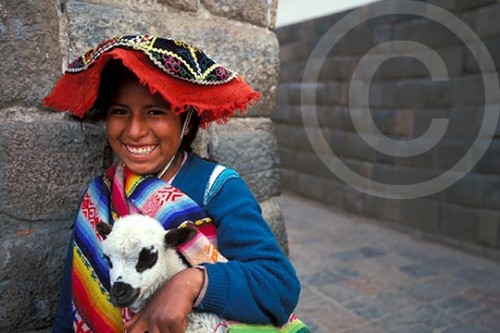 It’s like a gift, a quirky detail of Machu Picchu that brings the ancient ruins to life. Jeffrey does not move, and is able to shoot three or four frames before the llama walks away. Fortunately, Jeffrey knows he has just nailed the cover–especially before a gaggle of tourists rushes over, trying to create the same photograph.
It’s like a gift, a quirky detail of Machu Picchu that brings the ancient ruins to life. Jeffrey does not move, and is able to shoot three or four frames before the llama walks away. Fortunately, Jeffrey knows he has just nailed the cover–especially before a gaggle of tourists rushes over, trying to create the same photograph.As he ponders the luck of that moment, and thinks back to how hard he has worked over the past five days, he knows his credo couldn’t be more true:
“The harder you work, the luckier you become.”
This photograph was created with a Canon EOS 1V camera, a Canon 20mm lens, and Fuji Velvia film.
To read Fergus Bordewich’s mesmerizing and extensive article about Machu Picchu, click on this link: Smithsonian Magazine—“Winter Palace.”
I’d also love to hear from you! If you’ve been to Machu Picchu, drop me a comment and tell me your most memorable moment. And if you haven’t, would you ever like to go? It’s now in the running as one of the NEW Seven Wonders of the World.
___________________________________________________________________11/9/11
Behind the scenes: It’s 1981 and Jeffrey is photographing in Beijing, China. On this day he’s intent on capturing the beauty of the Summer Palace, the former warm-weather residence of China’s imperial rulers.
As Jeffrey crosses a narrow covered walkway, intricately carved and painted with imperial scenes, he notices an elderly gentleman sitting on one of the wooden railings. The man, who seems content to do little more than take in the day’s events around him, is dressed in a Mao jacket and a traditional cap. He is also wearing some of the most exquisite glasses Jeffrey has ever seen.
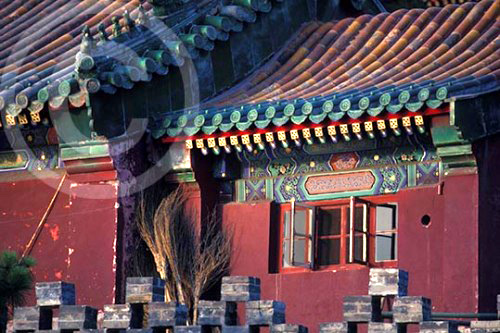 The spectacles rest slightly askew on the man’s nose. The etched hand-tooled silver that frames the circular glass is worn to a salient patina; the crack in the upper left-hand lens holds a story from long ago.
The spectacles rest slightly askew on the man’s nose. The etched hand-tooled silver that frames the circular glass is worn to a salient patina; the crack in the upper left-hand lens holds a story from long ago.Jeffrey cannot take his eyes off the man whose face perfectly symbolizes traditional China. When the man glances up, Jeffrey asks—through his interpreter—if he would mind having his portrait taken. “Please be sure to tell him how much I admire his glasses,” Jeffrey adds.
The man’s eyes twinkle from beneath their narrow openings. Then his soft, gravely voice begins wrapping Jeffrey in staccato Mandarin, almost as if the man has been waiting his entire life to share this moment. Jeffrey, who has studied a little Chinese, can only understand part of what he is saying, and must wait patiently until his interpreter finally relays the story.
“He says that he is 84-years old and these glasses have been in his family for two generations. His father wore them most of his life, then when he died, they were passed on to him. He said he would be willing to sell them to you for ten dollars.”
Jeffrey is horrified by his offer, imagining all the things that have passed through these lenses. He takes a moment, then simply says to his interpreter,
“Tell him ‘thank you very much for your generous offer’, but I will pay him double if he promises to never sell these glasses; to always keep them in his family.”
The man squints his eyes in delight, then agrees. Finally Jeffrey creates his portrait. A few years later it becomes the cover of Vis a Vis, United Airlines’ inflight magazine, when they publish a 10-page portfolio featuring Jeffrey’s China photographs.
This photograph was created with a Nikon FE camera, a Nikon 85mm lens and Kodachrome 64 film.
_________________________________________________________________
1/26/12
This Thursday’s Picture of the Week has little to do with exotic locations or unusual circumstances. Rather, it has everything to do with what it represents: belief.
Behind the Scenes: Aspen 1981—Snow is falling in fat, heavy flakes. Jeffrey knows it’s a perfect morning to create a photograph he’s been envisioning since he took a photo workshop from renowned photographer, Ernst Haas, several months earlier.
Haas is considered one of the most important figures in 20th century photography and is lauded as a leader in the art of color imagery.
Jeffrey has only owned a camera for a few years and is awash in enthusiasm for the art form, and the unlimited possibilities it offers.
 The workshop Haas leads at Anderson Ranch Arts Center focuses on motion, a technique he pioneered when he photographed bullfighting and the Indianapolis 500 in the 1950′s. Instead of shooting a fast shutter speed and freezing the subjects, as was typical of the time, he shot them with a slow shutter speed to capture the beauty of the motion.
The workshop Haas leads at Anderson Ranch Arts Center focuses on motion, a technique he pioneered when he photographed bullfighting and the Indianapolis 500 in the 1950′s. Instead of shooting a fast shutter speed and freezing the subjects, as was typical of the time, he shot them with a slow shutter speed to capture the beauty of the motion.• • •
“To express dynamic motion through a static moment became for me limited and unsatisfactory. The basic idea was to liberate myself from this old concept and arrive at an image in which the spectator could feel the beauty of a fourth dimension, which lies much more between moments than within a moment. In music one remembers never one tone, but a melody, a theme, a movement. In dance, never a moment, but again the beauty of a movement in time and space.”
–Ernst Haas
The approach Haas teaches at his workshop resonates with Jeffrey, and he knows he wants to capture the beauty and fluidity of horses running in the snow.
• • •
On the morning of the snowstorm, while most people are loading up their skis or hunkering down with a hot cup of coffee and a good book in front of the fireplace, Jeffrey puts on his heavy Sorrel boots, gets in his car and drives up Red Mountain.
After navigating the steep, windy road overlooking town, he parks his car next to a small meadow where horses are being boarded for the winter. The wind is blowing, flakes are sailing, and the horses begin running as soon as Jeffrey gets out of his car.
Jeffrey raises his camera and captures poetry in motion.
• • •
What happens next is where belief comes into play…
A few years later, Jeffrey is asked to be a part of a group exhibition at Unicorn Gallery, an Aspen gallery owned by entrepreneur Randy Woods. Jeffrey is humbled to be in the company of abstract painter, Richard Carter (former assistant to renowned artist Herbert Bayer of the Bauhaus School), and print maker, Tom Benton, creator of the famous Hunter Thompson campaign posters of the 70s.
On the night of the opening, the gallery is abuzz with art enthusiasts, including internationally reputed photographer Ferenc (Franz) Berko.
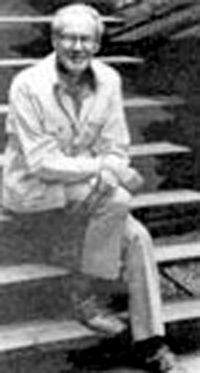 Berko, a tall, slender, ascot-wearing European transplant, greets Jeffrey with a gentle smile and quiet hello.
Berko, a tall, slender, ascot-wearing European transplant, greets Jeffrey with a gentle smile and quiet hello.Franz and his wife, Mirte, had come to Aspen in 1949 at the invitation of Walter Paepcke to photograph the Goethe Bicentennial. It was during the age of Aspen’s transformation from purely a silver mining town to a world-class ski resort and artist colony.
The Berkos were enamored with the mountains and town and ended up staying permanently. Below are a few images Franz shot over the years, when he not only turned his camera on the Goethe Bicentennial, but the Aspen Institute, the Aspen Music Festival and numerous other subjects.
©Berko Photos: Top (L) Arthur Rubinstein, (R) Albert Schweitzer, Middle (L) Work on the Herbert Bayer wall, (R) Ski touring up Pearl Pass. Bottom (L) Children, (R) Overview of ballerina
• • •
Later during the opening Berko approaches Jeffrey once again. This time he simply says, “I would like to buy a print of your horses running for my daughter.”
Jeffrey is stunned.
He smiles and stammers for a minute, then replies, “Franz, I would like to give you a print.”
Franz will have nothing to do with it.
“No, I insist I pay you for it. Your art is worth much more than you are asking. Please make me a print and bring it to Mirte’s toy store next week.”
“There’s only one thing,” he continues, “you must sign it.”
At that moment, Jeffrey knows for certain he is headed in the right direction following his passion for photography.
• • •
Franz and Jeffrey soon become dear friends, and Franz stays deeply interested in Jeffrey’s career, often giving him quiet advice throughout the years, until his death in 2000.
This photograph of the horses running will always remain a special image to Jeffrey because it represents so many things to him: his love of photography, his inner drive and enthusiasm when he was just beginning his career, and most of all, somebody’s belief in him and his ability to see.
“When you’re just starting out and one of the most respected photographers in the art world appreciates your work enough to buy a print, there’s no greater approval,” Jeffrey says.
• • •
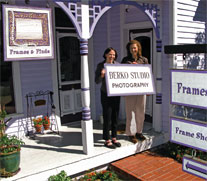 In a “small world” twist, the Berko Gallery, which is run by Franz’s granddaughter, Mirte Mallory, is now housed in a charming purple Victorian on Aspen’s Main Street—a home that Jeffrey and I owned and lived in for many years in the mid-1990’s.Yep, see that brick walkway? Jeffrey and I laid it with our own hands. “Our” purple Victorian will always hold sweet memories for us, and now it’s even more special because it holds the photographs of somebody who not only made a powerful impact on Jeffrey’s career, but also his life.
In a “small world” twist, the Berko Gallery, which is run by Franz’s granddaughter, Mirte Mallory, is now housed in a charming purple Victorian on Aspen’s Main Street—a home that Jeffrey and I owned and lived in for many years in the mid-1990’s.Yep, see that brick walkway? Jeffrey and I laid it with our own hands. “Our” purple Victorian will always hold sweet memories for us, and now it’s even more special because it holds the photographs of somebody who not only made a powerful impact on Jeffrey’s career, but also his life.Now it’s your turn. Who has been the “Franz” of your life? Who has believed in you and given you the confidence to reach your potential? I’d love to hear all about this wonderful person!
_________________________________________________________________
3/22/12
 Behind the Scenes: It’s 1989 and the Khmer Rouge are still fighting in Cambodia. Pol Pot’s official reign of genocidal terror has ended, but the aftermath of the “Killing Fields,” as it was coined in the grizzly 1984 film, still lingers.
Behind the Scenes: It’s 1989 and the Khmer Rouge are still fighting in Cambodia. Pol Pot’s official reign of genocidal terror has ended, but the aftermath of the “Killing Fields,” as it was coined in the grizzly 1984 film, still lingers.Jeffrey is in Cambodia with Harry Rolnick, a foreign correspondent for the Bangkok Post. They are there to tell the story of the restoration quietly taking place at Angkor Wat Temple Complex. A handful of scientists from the Archaeological Survey of India have begun work on Cambodia’s most important archaeological site.
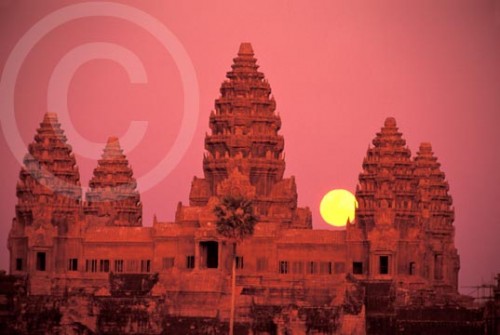 Angkor Wat, an ancient city built by King Survyavarman II in the 12th century, has taken a beating from years of neglect and non-stop fighting. Khmer Rouge guerrillas have looted temples, decapitated sculptures, and sold the spoils on the black market to raise cash for the war. The site’s exquisite Khmer architecture, which is often compared to that of ancient Greece and Rome in importance, has also been strangled by the encroaching jungle. Vines and roots have damaged structures, causing many of its sandstone temples, reliefs, and statues to crumble.
Angkor Wat, an ancient city built by King Survyavarman II in the 12th century, has taken a beating from years of neglect and non-stop fighting. Khmer Rouge guerrillas have looted temples, decapitated sculptures, and sold the spoils on the black market to raise cash for the war. The site’s exquisite Khmer architecture, which is often compared to that of ancient Greece and Rome in importance, has also been strangled by the encroaching jungle. Vines and roots have damaged structures, causing many of its sandstone temples, reliefs, and statues to crumble.The restoration of Cambodia’s most important site (and symbol) is a tiny glimmer of hope for a country that has not dared to hope since the Khmer Rouge murdered approximately two million of its people (one quarter of the population).
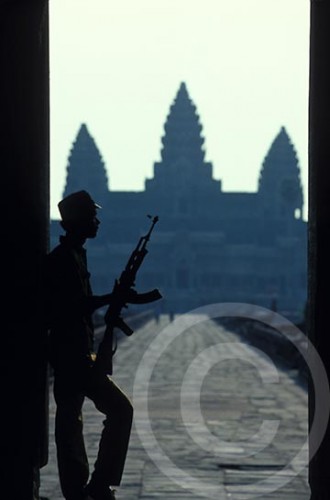 Because the U.S. still has not established diplomatic relations with Cambodia after Pol Pot’s reign of terror, Jeffrey and Harry must first fly from Bankgok, Thailand to Ho Chi Minh City, Vietnam to obtain a visa to enter the country. A few days later they will backtrack to the capital of Cambodia, Phnom Penh, then they will catch a puddle-jumper plane to Siem Reap, the province in which Angkor Wat is located.
Because the U.S. still has not established diplomatic relations with Cambodia after Pol Pot’s reign of terror, Jeffrey and Harry must first fly from Bankgok, Thailand to Ho Chi Minh City, Vietnam to obtain a visa to enter the country. A few days later they will backtrack to the capital of Cambodia, Phnom Penh, then they will catch a puddle-jumper plane to Siem Reap, the province in which Angkor Wat is located.After a hard and fast landing (to avoid gunfire, they are told), they head to the Grand Hotel, the only hotel operating in the area at the time. Tourism has been at a standstill for more than a decade. When the bellman of this dilapidated establishment leads Jeffrey and Harry to their rooms, Jeffrey notices that his bed is pushed awkwardly into a far corner. When he asks about it, the bellman explains, “That is for your safety—in case there is gunfire. Bullets will not be able to hit you over here if they come through your window.”
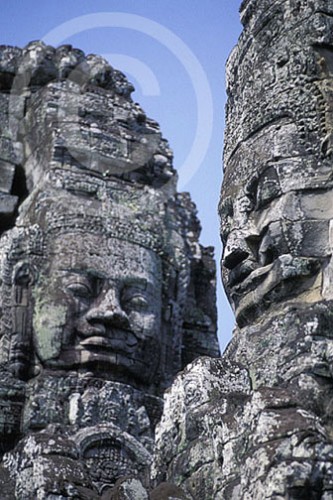 The next day an interpreter and several Cambodian soldiers meet Harry and Jeffrey on the outskirts of Angkor Wat. The complex is over five hundred acres, and they must walk through the jungle to the temples where the archaeologists are working. The men are told under no uncertain terms may they leave the single narrow path they plying. Live mines litter the landscape everywhere else. Nearby gunfire reminds them that this is no idle warning.
The next day an interpreter and several Cambodian soldiers meet Harry and Jeffrey on the outskirts of Angkor Wat. The complex is over five hundred acres, and they must walk through the jungle to the temples where the archaeologists are working. The men are told under no uncertain terms may they leave the single narrow path they plying. Live mines litter the landscape everywhere else. Nearby gunfire reminds them that this is no idle warning.Jeffrey and Harry walk cautiously and stick closely to the Cambodian soldiers who know every inch of the area. The emptiness of Angkor Wat and the heavy air blanketing the jungle creates an eeriness that makes the back of Jeffrey’s neck prickle. Harry continually looks over his shoulder. Even the slightest snap of a twig from a jungle creature or birds taking flight makes them pause. Jeffrey can’t help wonder, How do we know the Khmer Rouge haven’t laid another mine on the path last night and how do we know we won’t be ambushed now?
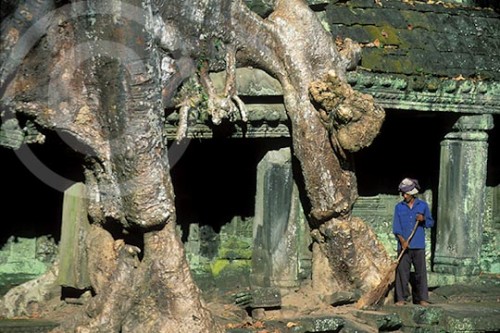 Eventually they arrive where the archaeologists are working. The interpreter introduces the men and points out many of the sites wonders, including giant Hindu sandstone faces, exquisite bas-reliefs, and temples covered in roots more massive than each of them. It doesn’t take long before Jeffrey is able to create a powerful visual story about what is taking place here.
Eventually they arrive where the archaeologists are working. The interpreter introduces the men and points out many of the sites wonders, including giant Hindu sandstone faces, exquisite bas-reliefs, and temples covered in roots more massive than each of them. It doesn’t take long before Jeffrey is able to create a powerful visual story about what is taking place here.After spending the entire day at Angkor Wat, they make their way back out to the other side where a car is expected to be waiting for them. As they reach the outskirts of the site and walk along a road near a small village, they come upon a young boy carrying an AK-47 rifle. This barefoot youngster, who is wearing nothing more than threadbare shorts, is protecting his village against the Khmer Rouge. As he walks under the weight of his gun, his onyx eyes reveal a life that has already witnessed far too much.
Jeffrey can’t help but think back to his own carefree childhood, and tries to swallow the sadness rising in his throat as he gets down on his knees to create this boy’s portrait. He can only hope that peace will come soon to Cambodia, and with it, a return to childhood for this young “man.”
This photograph was created with a Nikon F4, a Nikor 24mm lens and Fuji Velvia film.
Postscript: Jeffrey has returned to Angkor Wat on assignment two more times since his first trip in 1989, and each time he has witnessed it coming back to life more and more. Restoration is now nearly complete and Angkor Wat has been listed as a World Heritage Site, along with Cambodia’s largest tourist attraction. The best part is that Jeffrey has never come across another child carrying an AK-47 rifle in Cambodia.
If you want to learn more about Angkor Wat, click HERE.
___________________________________________________________________
3/29/12
Behind the Scenes: The year is 1995 and Jeffrey is photographing on assignment for The New York Times Travel Section in Beijing, China. He’s there to do a story about Ritan (Temple of the Sun) Park.
This expansive park is one of the oldest sites in Beijing and is like an oasis in the midst of a teeming metropolis. Commissioned by Ming Dynasty emperor JiaJing in 1530, it is filled not only with massive trees, gardens, pavilions, and small lakes, but many places for people to gather and recreate. Tai chi and ballroom dancing are common forms of exercise found here.
When Jeffrey comes upon this elderly gentleman wearing a traditional Mao jacket, fully immersed in the solitude of his early morning ritual, he knows he has captured the essence of Ritan Park and also created a wonderful symbol of ancient China–still alive and well in modern day Beijing.
At its core, tai chi is a martial art (also referred to as shadow boxing), but it is now commonly practiced to strengthen and promote mind/body health. Jeffrey loved how the man was entranced in the shadow of his own dance, and how the traditional Chinese red wall and green tiles melded with the shadow and gesture, creating pure harmony.
This image was created with a Nikon F4, a Nikkor 85mm lens and Fuji Velvia film.
Postscript: A week after it was published as the cover of The New York Times Travel Section, Broadway’s legendary song and dance man, Tommy Tune, wrote a letter to the editor extolling the artistic merits of Jeffrey’s photograph and how he captured the magic of the moment.
“It was quite an honor coming from Tommy Tune, whom I admire for his artistry and accomplishments in the field of dance,” said Jeffrey. “The fact that he would take the time to write a letter to the editor…there really is no higher compliment.”

